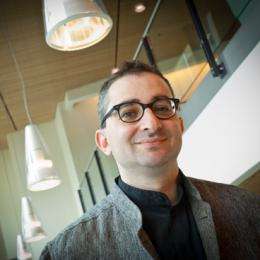Study shows scientists' location influences how widely their work is read, used for innovations

Do scientists' job locations have any impact on the way their work spreads? Or, in today鈥檚 highly networked world, does research flow around the globe without regard to its point of origin? According to a study co-authored by an MIT economist, location still does matter 鈥� a finding with implications for technology transfer, the process of deriving innovations from pure research.
The study shows that when scientists switch jobs 鈥� and job locations 鈥� during their careers, the move has two distinct effects on their influence. First, their papers gain citations from scholars who are their new neighbors, even as their citation frequency in papers by their former neighbors remains constant.
But when it comes to patents, scientists who move see a significant reduction in the rate at which their work becomes the basis for new technologies in their old locations. For innovation, face-to-face contact matters.
鈥淎cademic researchers manage to get colleagues at their new location excited about their prior work, and academics back at the point of origin don鈥檛 forget about the work,鈥� says Pierre Azoulay, the MIT associate professor who collaborated on the work. However, he adds, 鈥淔irms will forget.鈥�
The results, , 鈥淭he Diffusion of Scientific Knowledge Across Time and Space: Evidence from Professional Transition for the Superstars of Medicine,鈥� come from a close tracking of 9,483 life scientists, about a third of whom relocated a distance of at least 50 miles between 1975 and 2004. The study incorporated more than 52,000 papers published by this cohort of scientists.
The data show that after scientists move, citation frequency in their old locations remain steady for at least a decade. However, citation rates in the new locations increase about 50 percent, on average, reaching a new peak about two years after the move and remaining at these elevated levels for a decade.
Conversely, within three years of scientists鈥� moves, their papers are incorporated into considerably fewer patents in their former locations, dropping especially sharply after seven years. However, there is a net increase in scientists鈥� patent activity at their new locations, so the overall effect of scientists鈥� movement on patent activity is a wash.
Azoulay, the Zenon Zannetos (1955) Career Development Professor at the MIT Sloan School of Management, conducted the study with Joshua Graff Zivin, an associate professor of international relations and Pacific studies at the University of California at San Diego, and Bhaven Sampat, an assistant professor in the Department of Health Policy and Management at Columbia University鈥檚 Mailman School of Public Health.
Hub, hub, hooray
The study鈥檚 findings provide further evidence that the existence of research hubs in which universities and industry lie in close proximity 鈥� as in the Boston area, Silicon Valley and the San Diego area in California, or the Research Triangle in North Carolina 鈥� help foster a productive interchange among researchers and technologists.
鈥淚t鈥檚 consistent with the idea that hubs are a constructive model,鈥� Azoulay says. 鈥淪ometimes a scientist needs to hold the hand of a firm 鈥� as they grapple with the implications of the research.鈥�
While the notion that research hubs are important in technology transfer is not new, the paper generates new insights about the dynamics of knowledge around hubs. The study鈥檚 design paired the papers of scientists who moved with papers that had near-identical citation statistics at the same time, but were produced by scientists who did not change locations. In this way the study isolates the effects of movement on the flow of scientific knowledge.
鈥淭he main contribution of the paper is tracing people鈥檚 movements across time and space, and studying the effects of their output before and after those moves,鈥� says Azoulay, whose work often analyzes the scientific enterprise.
This study, like several others Azoulay has published, uses what economists call the 鈥渃itation revolution鈥� in the study of science. The proliferation of online databases now allows social scientists to track the influence of scientists鈥� work and the geographic patterns that result.
Other economists say the paper helps show how location matters. 鈥淎zoulay, Zivin and Sampat have accumulated a fascinating new dataset that sheds important light on the nature of interactions whereby academic researchers learn from each others鈥� work,鈥� states Adam Jaffe, dean of arts and sciences and Fred C. Hecht Professor of Economics at Brandeis University, responding to questions by e-mail. 鈥淭his kind of research is key to understanding why science and innovation thrive in some metropolitan areas but not in others.鈥�
Josh Lerner, the Jacob H. Schiff Professor of Investment Banking at Harvard Business School, who has long studied technological innovation, says the paper raises 鈥渁n important question, as government policy can affect the mobility of scientists in many ways, from technology-transfer licensing rules to grant choices.鈥�
The study produced one additional, intriguing quirk, Azoulay notes: It suggests that the movement of scientists from job to job in academia is beneficial in aggregate, since it increases paper citations while the rate of patenting remains the same (though shifted in its geographic distribution).
To maximize the flow of knowledge, Azoulay says, 鈥淵ou鈥檇 like academics to move around more than they do.鈥�
Lerner calls it an 鈥渋ntriguing conclusion that barriers to scientific mobility may actually be socially detrimental, as they prevent the kind of knowledge gains from the mixing of ideas.鈥�
The paper will appear in a volume, to be published by the University of Chicago Press, on the proceedings of the National Bureau of Economic Research鈥檚 50th Anniversary Conference on the Rate and Direction of Inventive Activity. The authors also presented the work at the conference, held last fall.
This story is republished courtesy of MIT News (), a popular site that covers news about MIT research, innovation and teaching.
Provided by Massachusetts Institute of Technology


















